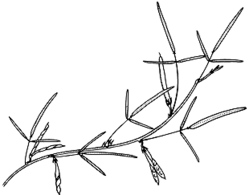
Description: Perennial twining or scrambling herbs, stoloniferous or non-stoloniferous; taproot woody.
Leaves alternate, pinnately or palmately 3-foliolate, some species dimorphic; terminal leaflet usually largest; stipules small; stipels small, ± caducous.
Chasmogamous inflorescences axillary, racemose; bracts lanceolate to linear; bracteoles mostly linear. Calyx 5-toothed, the 2 upper teeth joined for most of their length. Petals clawed; standard ± circular, larger than other petals; wings and keel ± oblong. Stamens diadelphous, 1 filament partly free; anthers uniform. Ovary subsessile, with 2–12 ovules; style ± upcurved; stigma small, hairy.
Pods oblong to linear, ± terete or compressed, sometimes curved, often twisting after seed dehiscence; seeds orbicular to quadrate; aril absent, caruncle small, papery, flap-like.
Distribution and occurrence: World: c. 26 spp., E Asia, W Pac.Is, Aust. Aust.: c. 24 spp. (native), all States.
Note: Cleistogamous inflorescences occur in most species; they have green flowers (often quite reduced), solitary or in a few-flowered clusters, in axils of lower leaves, or on specialised subterranean or sub-litter branches; pods oblong. In the specific descriptions the chasmogamous flowers, pods and seeds only are described. The seeds of G. max (L.) Merr., the Soybean, are one of the world's most important sources of protein and oil. Research on the allied Australian species is being carried out in Australia and the U.S.A. This genus is under revision
Text by B.E. Pfeil & M.D. Tindale
Taxon concept:
| | Key to the species | |
| 1 | Apex of mature fruit curved upwards before dehiscence. | 2 |
| Fruit straight before dehiscence. | 3 |
| 2 | Leaflet reticulation usually obvious; secondary veins ≥60°; mature fruit with purple flecks. | Glycine cyrtoloba |
| Leaflet reticulation obscure; secondary veins usually ≤50°; fruit without purple flecks.
Back to 1 | Glycine canescens |
| 3 | Leaflets palmately 3-foliolate. | 4 |
| Leaflets pinnately 3-foliolate.
Back to 1 | 6 |
| 4 | Leaflet reticulation obvious; stoloniferous. | Glycine microphylla |
| Leaflet reticulation obscure; not stoloniferous.
Back to 3 | 5 |
| 5 | Fruit 7–13-seeded; secondary veins ≥50°, obvious; seed surface rough, not mottled; terminal stipels usually present. | Glycine clandestina |
| Fruit 5–9-seeded; secondary veins ≤50°, obscure; seed surface smooth, mottled; terminal stipels usually absent.
Back to 4 | Glycine rubiginosa |
| 6 | Leaflet reticulation obscure; rachis ≤4 mm long; not stoloniferous; fruit 7–13-seeded. | Glycine clandestina |
| Leaflet reticulation usually obvious; rachis variable, often >4 mm long; stoloniferous or not stoloniferous; fruit 1–10-seeded, usually ≤8-seeded.
Back to 3 | 7 |
| 7 | Stoloniferous; adventitious root buds may be visible in axils of older stems, brown; leaflets with length:breadth ratio of ratio 1.3–7:1. | 8 |
| Not stoloniferous; lacking adventitious root buds; leaflets with length:breadth ratio of 1.1–20:1.
Back to 6 | 10 |
| 8 | Seeds with obvious raised warts (appearing granular under a microscope); leaflets with length:breadth ratio of 1.3–2.2:1; plants moderately hairy on most parts. | Glycine latifolia |
| Seeds with very obscure flattened warts; leaflets with length:breadth ratio of 1.6–7:1; plants sparsely hairy on most parts, or nearly glabrous.
Back to 7 | 9 |
| 9 | Seeds usually shortly barrel-shaped (rarely ± spherical); leaflets with length:breadth ratio of 1.6–4:1; secondary veins 30–60° from midvein (rarely to 70°); rachis often >2 mm long. | Glycine tabacina |
| Seeds usually ± spherical; leaflets with length:breadth ratio of 2–7:1; secondary veins 60–80° from midvein; rachis often <2 mm long.
Back to 8 | Glycine microphylla |
| 10 | Lower surface of leaflets moderately to densely hairy, upper surfaces sparsely to densely hairy; leaflets up to 38 mm wide; cleistogamous fruit either in leaf axils or on specialised branches arising from partly-covered aerial stems ('litter pods'). | Glycine tomentella |
| Lower surface of leaflets sparsely hairy, upper surfaces glabrous to sparsely hairy; leaflets up to 13 mm wide; cleistogamous fruit in leaf axils only.
Back to 7 | 11 |
| 11 | Fruit usually up to 6-seeded (rarely 7-seeded); fruit usually up to 28 mm long (rarely to 30 mm); sinus between upper calyx teeth 0.25–0.5 mm long. | Glycine stenophita |
| Fruit usually 6–9-seeded (rarely 4-seeded); fruit usually >28 mm long (rarely from 25 mm long); sinus between upper calyx teeth 0.25–1 mm long.
Back to 10 | Glycine pacifica |
|


